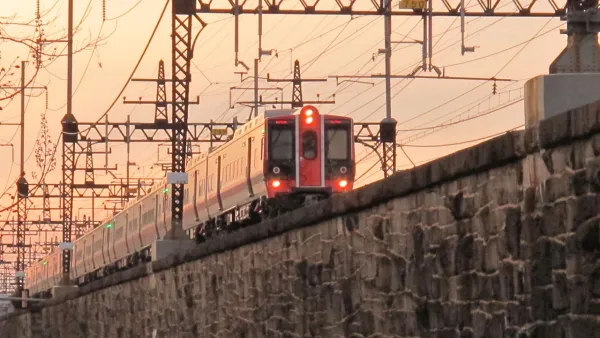Compared to Europe's high-speed rail, paved roads, and underground power lines, America lags behind with its unreliable trains, potholes, and overhead power lines. Uwe E. Reinhardt questions why Americans put up with the decaying infrastructure.

"Arriving at a destination on time, something Europeans take largely for granted, is relatively rare on Amtrak," writes Reinhardt. "Furthermore, the train in Europe or Asia is likely to have traveled at much higher speed. The tracks there are so smooth that one could easily carry an open cup of coffee along several cars or work on the computer." This cannot be said in America, where cars bump over potholes, trains screech along old rails, and departure times are often inaccurate. Reinhard remarks, "Why and how Americans, who pride themselves on being fussy consumers, have put up with this mid-20th-century rail system is a mystery."
"Even more wondrous than the archaic subway and rail system and potholes in the streets," continues Reinhardt, "is the system of distributing electric power to households and factories in large parts of the Northeastern United States." Power is carried through lines strung on leaning poles, "which are vulnerable to powerful storms, like Hurricane Sandy," in contrast to most of Europe's underground and well-maintained power lines. Reinhardt brings up an anecdote in which his visiting friend from Germany "burst out laughing at the abundance of wires in every direction, something he had seen only on his travels to the developing world."
Why do Americans "put up so fatalistically with this old-fashioned and decaying infrastructure"? Reinhardt calls for a better balance between the private and public sector to bring America's infrastructure up to 21st-century standards instead of suffering "for days or weeks without light, heat and transportation, verbally shaking our fists at the power companies but leaving it at that."
FULL STORY: America’s Mid-20th-Century Infrastructure

Analysis: Cybertruck Fatality Rate Far Exceeds That of Ford Pinto
The Tesla Cybertruck was recalled seven times last year.

National Parks Layoffs Will Cause Communities to Lose Billions
Thousands of essential park workers were laid off this week, just before the busy spring break season.

Retro-silient?: America’s First “Eco-burb,” The Woodlands Turns 50
A master-planned community north of Houston offers lessons on green infrastructure and resilient design, but falls short of its founder’s lofty affordability and walkability goals.

Test News Post 1
This is a summary

Analysis: Cybertruck Fatality Rate Far Exceeds That of Ford Pinto
The Tesla Cybertruck was recalled seven times last year.

Test News Headline 46
Test for the image on the front page.
Urban Design for Planners 1: Software Tools
This six-course series explores essential urban design concepts using open source software and equips planners with the tools they need to participate fully in the urban design process.
Planning for Universal Design
Learn the tools for implementing Universal Design in planning regulations.
EMC Planning Group, Inc.
Planetizen
Planetizen
Mpact (formerly Rail~Volution)
Great Falls Development Authority, Inc.
HUDs Office of Policy Development and Research
NYU Wagner Graduate School of Public Service


























